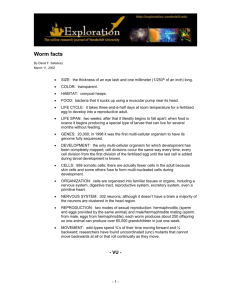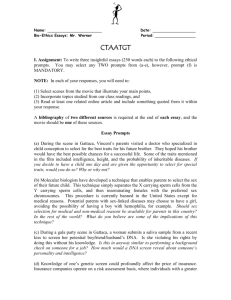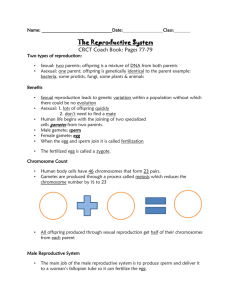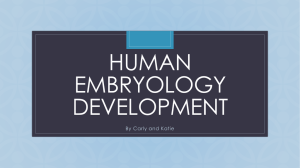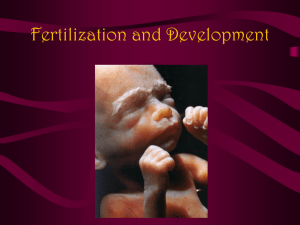INTRODUCTION TO PSYCHOLOGY 201 Summary Notes
advertisement
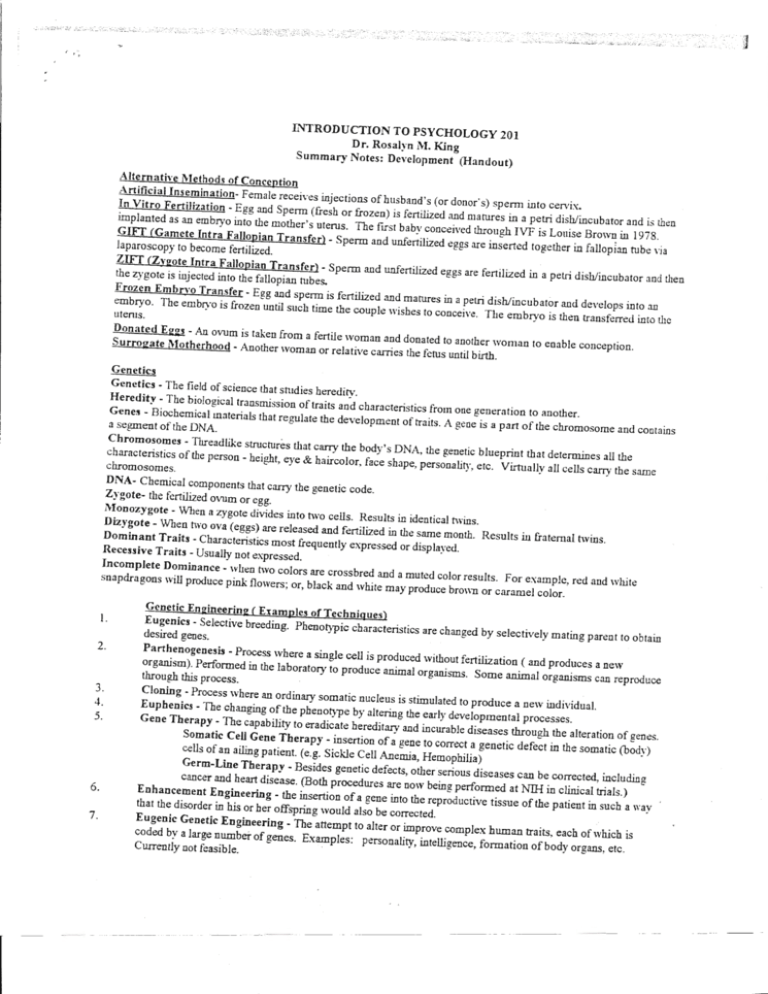
l' I ~ INTRODUCTION TO PSYCHOLOGY 201 Dr. Rosal~·n M. King Summary Notes: DeYclopment (Han dout) Alternative Methods of Conception Artificial Insemination- Fem ale receives injections of husband's (or donor's) sperm into cervix. In Vitro Fertilization - Egg and Sperm (fresh or frozen) is fertilized and matures in a petri dish/incubator and is then implanted as an embryo into the mother's uterus. The first baby conceived through IVF is Louise Brown in 1978. GIFT (Gamete Intra Fallopian Transfer) - Sperm and unfertilized eggs are inserted together in fallopian tube Yia laparoscopy to become fertilized. ZIFT (Zvgote Intra Fallopian Transfer) - Sperm and unfi:rtilized eggs are fertilized in a petri dish/incubator and then the zygote is injected into the fallopian n1bes. Frozen EmbrYo Transfer - Egg and sperm is fertilized and matures in a petri dish/incubator and develops into an embryo. The embryo is frozen until such time the couple wishes to conceive. The embryo is then transferred into the utems. Donated Eggs - An ovum is taken from a fertile woman and donated to another woman to enable conception. Surrogate Motherhood - Another woman or relative carries the fetus until birth. Genetics Genetics - The field of science that studies hereditv. Heredity - The biological transmission of traits and characteristics from one generation to another. Genes - Biochemical materials that regulate the development of traits. A gene is a part of the chromosome and contains a segment of the DNA. Chromosomes - Threadlike structures that carry the body's DNA, the genetic blueprint that determines all the characteristics of the person - height, eye & haircolor, face shape, personality, etc. Virnially all cells carry the same chromosomes. DNA- Chemical components that carry the genetic code. Zygote- the fertilized ovum or egg. Monozygote - When a zygote divides into two cells. Results in identical twins. Dizygote - When two ova (eggs) are released and fertilized in the same month. Results in fraternal twins. Dominant Traits - Characteristics most frequently expressed or displayed. ~ecessive Traits - Usually not expressed. Incomplete Dominance - when two colors are crossbred and a muted color results. For example, red and white snapdragons will produce pink flowers; or, black and white may produce bro\m or caramel color. I. 2. 3. 4. 5. 6. 7. Genetic Engineering ( Examples of Techniques) Eugenics - Selective breeding. Phenotypic characteristics are changed by selectively mating parent to obtain desired genes. Parthenogenesis - Process where a single cell is produced without fertilization ( and produces a new organism). Performed in the laboratory to produce animal organisms. Some animal organisms can reproduce through this process. Cloning - Process where an ordinary somatic nucleus is stimulated to produce a new individual. Eupbenics - The changing of the phenotype by altering the early developmental processes. Gene Therapy - The capability to eradicate hereditary and incurable diseases through the alteration of genes. Somatic Cell Gene Therapy - insertion of a gene to correct a genetic defect in the somatic (body) cells of an ailing patient. (e.g. Sickle Cell Anemia, Hemophilia) Germ-Line Therapy - Besides genetic defects, other serious diseases can be corrected, including cancer and heart disease. (Both procedures are now being performed at Nill in clinical trials.) Enhancement Engineering - the insertion of a gene into the reproductive tissue of the patient in such a \YaY that the disorder in his or her offspring would also be corrected. Eugenic Genetic Engineering - The attempt to alter or improve complex human traits, each of which is coded by a large number of genes. Examples: personality, intelligence, formation of body organs, etc. Currently not feasible. --- - \- - -- - - - - - - - - - - -- - .. -" ~ '~., _- ~- . ·-~ ·""'- Page 2) Summary Notes - Development Prenatal Techniques for Diagnosis of Birth Defects Amniocentesis - Drawing of sample of amniotic fluid. (16th to 18th week) Chorionic Villus Sampling - A culture of tissue is taken for diagnosis from around the membrane of the embryo which is made up of fetal cells. Alpha Fetoprotein Test (ATP) - Blood test that analyzes the amount of alpha fetoprotein it contains. Test is appropriate for women at risk of bearing children with defects such as anencephaly or spina bifida and Down Syndrome. (16th to 18th week) · Ultrasound - High frequency sound waves directed into the abdomen of pregnant women to yield a sonog:ram - a picture of the uterus. fetus and placenta. Provides the clearest images yet of the fetus in utero. Umbilical Cord Assessment - Insertion of a needle in the umbilical cord with use of ultrasound to draw fetal blood. They can get a blood count, examine liver function and assess other bodily functions of the fetus. Can also test for infection, anemia, certain metabolic disorders and immunodeficiencies and heart failure. Fetoscopy - Insertion of lighted lens into uterus to look at the organs of the fetus and determine abnonnalities (if any). Preimplantation Genetic Diagnosis - When fertilization occurs in the laboratory through IVF, a physician can identify genetic defects in embryos of from 4 to 8 cells. Can detect such defects as cystic fibrosis. Defective embryos are not implanted. Maternal and Paternal Factors to Prenatal De\'elopment Maternal Factors Poor Nutrition Drugs and Other Substances: DES (Diethylstilbestrol, a synthetic hormone given to prevent miscarriage); Nicotine, Caffeine, Alcohol, Marijuana, Morphine, Heroin, Codeine, Cocaine, Accutane (An acne medication), Antibiotics, Anticonvulsant Drugs, Aspirin, Hallucinogenic Drugs,Insulin and Tolbutamide, Sex hormones, Thalidomide, Hexachorophene (a chemical once used in disinfectant soaps), Polychorinated Biphenyls (PBCs) Illnesses and Diseases: Rubella or german measles; Toxoplasmosis (infection from feces of cats and red meat); Influenza; Mumps; Polio; Toxemia; HIV & AIDS; Diabetes; TB; STDs - gonorrhea, genital herpes, syphillis. Incompatibility of Blood Type Radiation: X-rays, Video Display Terminals, Nuclear Radiation. Environmental Factors: Chlorine in Tap Water, Pesticides, and other environmental pollutants. Paternal Factors Exposure to lead, drugs and other substances, nicotine, large amounts of alcohol, radiation, DES, pesticides can result in the production of abnormal sperm. Electromagnetic Fields, especially the work of electrical and electronics workers - leads to nervous system tumors in offspring. On the job exposure to certain chemicals such as lead, benzene, paint solvents, vinyl chloride, carbon disulphide, the pesticide DBCP, anesthetic gases and radiation. rmk ----------


